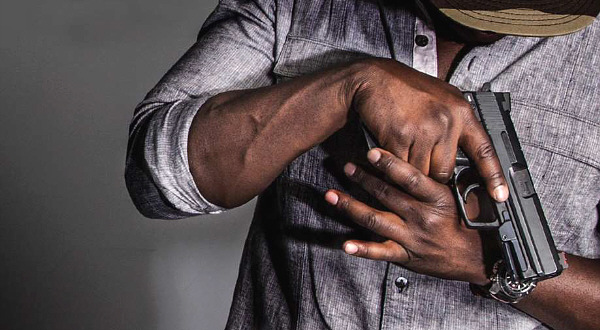

Michigan Incident Highlights
the Role of Armed Civilians

(NRA)
By Susanne Edward. Aug 1, 2025
Article Source
A knife-wielding man injured 11 people during a violent rampage inside a Walmart in Traverse City, Mich., on July 26—before being stopped by a legally armed bystander in the parking lot.
As chaos erupted, Derrick Perry, a retired U.S. Marine who was shopping with his wife, drew his concealed handgun and confronted the attacker in the parking lot. Without firing a shot, Perry ordered the suspect to drop the knife and held him at gunpoint until police arrived—a swift action authorities say likely prevented more bloodshed.
The attacker now faces terrorism and multiple assault charges. Victims ranged in age from 29 to 84—all are expected to survive. Law enforcement praised Perry and other civilians for their swift response, which unfolded within moments—well before the first officers arrived at the scene.
In a state where concealed carry is not overly restricted, this incident underscores the real-world impact of armed citizens already present when seconds count.
Defensive Gun Use in the United States
While they rarely make headlines, incidents involving armed citizens stopping crimes are not uncommon in the United States; however, they tend to receive less national media coverage than high-profile shootings.
A comprehensive study published by the Centers for Disease Control and Prevention (CDC) in 2013, based on research commissioned during the Obama administration, found that Americans use firearms defensively between 500,000 and 3 million times per year. Most of those instances, according to the study, involve non-lethal outcomes where the presence of a gun deters a crime without a shot being fired.
A more recent 2021 analysis by Georgetown University's McDonough School of Business estimated the number of annual defensive gun uses at approximately 1.67 million. These figures include instances of home defense, deterrence of assaults and intervention in public attacks, like the one in Michigan.
According to the Federal Bureau of Investigation's Uniform Crime Reporting (UCR) Program, more than 2,000 verified justifiable homicides by private citizens occurred between 2017 and 2021; however, researchers caution that the number is likely underreported due to inconsistent categorization by local departments.
Concealed Carry and the Legal Framework
Perry, who intervened in Traverse City, has a valid concealed handgun license, a requirement under Michigan law for carrying a concealed handgun in public.
As of 2024, more than 21.5 million Americans held concealed carry permits, according to data compiled by the Crime Prevention Research Center (CPRC). The center also found that permit holders are statistically less likely to commit firearm violations than the general public. For example, in Texas and Florida, two states that track such data, concealed-carry permit holders were convicted of gun-related crimes at rates significantly lower than even law enforcement officers.
Michigan is a "shall-issue" state, meaning permits must be granted to applicants who meet statutory requirements, including passing a background check, completing an approved training course and being at least 21 years old.
Under Michigan law, the use of deadly force is permitted if a person "honestly and reasonably believes" such force is necessary to prevent imminent death, great bodily harm or a sexual assault.
However, in the case involving Perry, the mere presence of a firearm was enough to deter the assailant from harming more people. Police have not indicated any intention to charge the armed citizen in the July 26 incident.
Response Time and Public Safety
Police arrived on scene approximately six minutes after the first 911 call was placed, according to dispatch logs. Experts in emergency response note that such a time frame is considered prompt by law enforcement standards, but in active attack scenarios, even brief delays can allow a violent criminal to harm or murder many people.
According to the Bureau of Justice Statistics, the average police response time for violent crimes is approximately 11 minutes nationwide. Clearly, the presence of a nearby civilian capable of responding can significantly reduce harm.
The Michigan incident is one of several recent cases in which armed civilians have intervened in public attacks. In 2022, a 22-year-old man in Greenwood, Ind., stopped a murderer inside a shopping mall just 15 seconds after the attack began. Four people were killed, but authorities said the toll could have been far worse without the intervention.
The incident in Grand Rapids adds to a growing list of cases in which armed civilians have played a direct role in stopping acts of violence. From small-town markets to city streets, incidents like this one demonstrate how individuals already present at the scene can reduce casualties when seconds matter and law enforcement is minutes away.
Discussions about firearms in America often focus on regulation and restriction, but stories like this highlight another dimension: prevention through lawful self-defense. These are not hypothetical scenarios; they are real events, involving real people, in real communities.
![]()
























